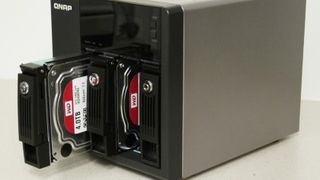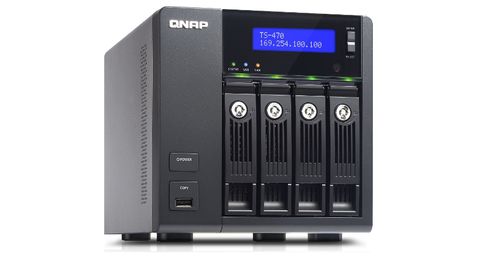Why you can trust TechRadar
Add-on apps are all well and good, but the main reason for buying the TS-470 is storage, with four disk bays located at the front with lockable slide-in carriers to take either 3.5-inch or smaller 2.5-inch SATA disks. Some sellers bundle disks with the appliance but we chose to fit our own, opting for 4TB Western Digital Red drives expressly designed for NAS use. In theory this gave us 16TB of raw capacity but, as with similar appliances, the default RAID 5 configuration applied by QNAP's QTS operating system takes a fair chunk of that to protect against drive failure.

A set of default shares is created during setup, but adding to these and managing access rights is very straightforward, and you can now build storage pools made up of multiple arrays from which virtual volumes are provisioned.
We tested on a Windows network and, although four Gigabit network ports come as standard on the TS-470, for our initial tests we connected just one to a suitable switch which, using the Atto benchmark, enabled us to record read and write throughput rates of around 118MB/sec. That's about as much as you can expect on a single Gigabit link, and when copying real files this figure fell to around 90-100MB/sec depending on file size (large files being quicker to copy).
With a 2.6GHz dual-core Celeron processor the TS-470 is capable of delivering this kind of throughput across all four Gigabit interfaces, with a choice of port trunking options to make setup easier. Most of these, however, had little effect on throughput with the best dependent on having a compatible switch capable of supporting the 802.3ad link aggregation protocol. An alternative and easier solution would be to connect each of the four interfaces to a different VLAN for concurrent access by multiple workgroups.
Faster and bigger
Another option is to swap out Gigabit ports three and four, which are on a plug-in adapter, and fit a dual-port 10GbE card instead. This would certainly improve throughput, but requires the purchase of a card costing almost as much as the original appliance. Not to mention a 10GbE network switch and 10GbE interfaces in selected servers and workstations to take advantage of the extra bandwidth. Few small businesses are likely to see this as a cost effective option.
Similarly, it's possible to forgo the extra network ports in favour of a QNAP SAS card enabling up to two 16-bay disk racks to be attached to the TS-470. However, we doubt many small businesses will take up this option which is, again, costly and seems a little out of place on a desktop NAS.
Some may well opt to take advantage of SSD caching, accessible if SSDs are installed instead of hard disks in up to two of the four bays. However, some caution is needed as this reduces capacity and will only improve performance for applications with heavy I/O requirements. It had a negligible impact on our simple file sharing tests.

